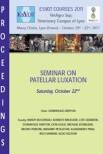OBJECTIVE: To compare pelvic limb kinetic and kinematic gait parameters between Dachshunds six months following hemilaminectomy for treatment of thoracolumbar disc extrusion (post-hemilaminectomy; PHL) and Dachshunds without history and clinical evidence of spinal cord disease (control; CON).
METHODS: The CON (n = 8) and PHL (n = 6) Dachshunds were recruited for objective gait evaluation. Kinetic data collected included peak vertical force (PVF), stance phase duration and swing phase duration. Kinematic data collected included tarsal, stifle and hip range of motion (ROM) during stance and swing phases of the trot, tail ROM, and horizontal and vertical components of pelvis ROM.
RESULTS: No significant differences were identified between tarsal, stifle, hip, and tail ROM between CON and PHL Dachshunds. Although PVF was not significantly different between CON and PHL Dachshunds, PVF varied on average by 14% between the pelvic limbs in PHL Dachshunds (p <0.01). Horizontal and vertical components of pelvic ROM were on average 51% and 36% greater in PHL Dachshunds compared to CON Dachshunds (p = 0.04 and p = 0.02 respectively).
CLINICAL SIGNIFICANCE: Six months after decompressive hemilaminectomy, Dachshunds have abnormal pelvic motion and asymmetric pelvic limb weight bearing. Pelvic sway (ROM) may be a more sensitive indicator of myelopathy than pelvic limb joint ROM and may serve as a useful objective tool to characterize response to treatment in patients with spinal cord disease.
Kinetic and kinematic gait analysis in the pelvic limbs of normal and post-hemilaminectomy Dachshunds
Journal
Sutton JS, Garcia TC, Stover SM, Sturges BK, O'Donnell M, Kapatkin AS. Vet Comp Orthop Traumatol. 2016 May 18 ;29( 3): 202-8.









